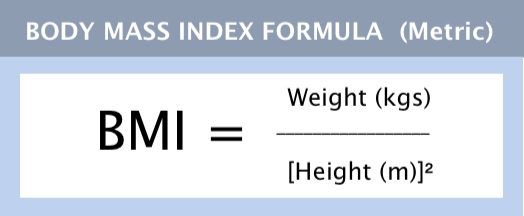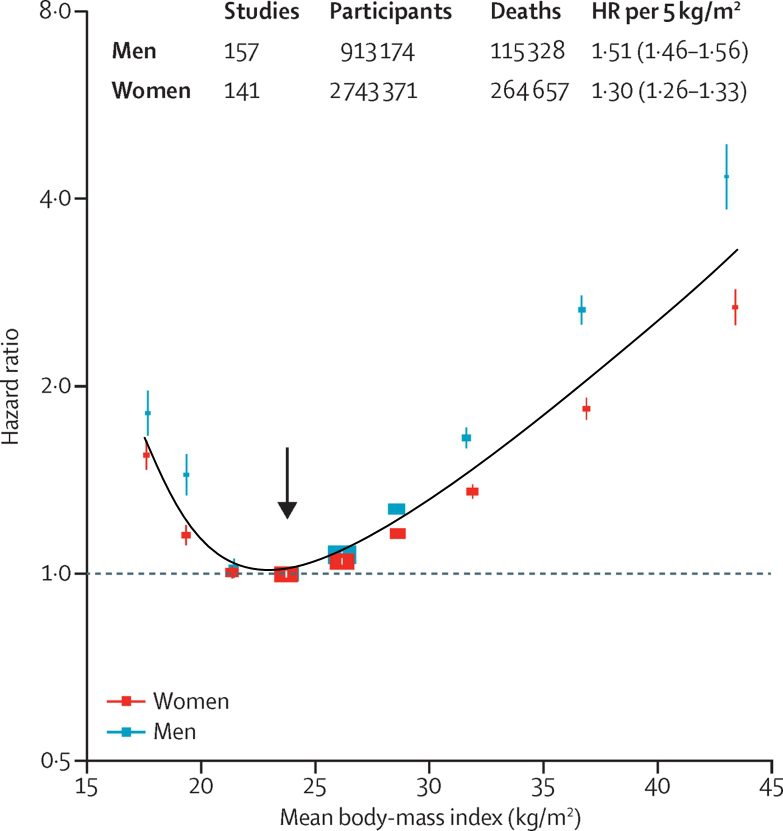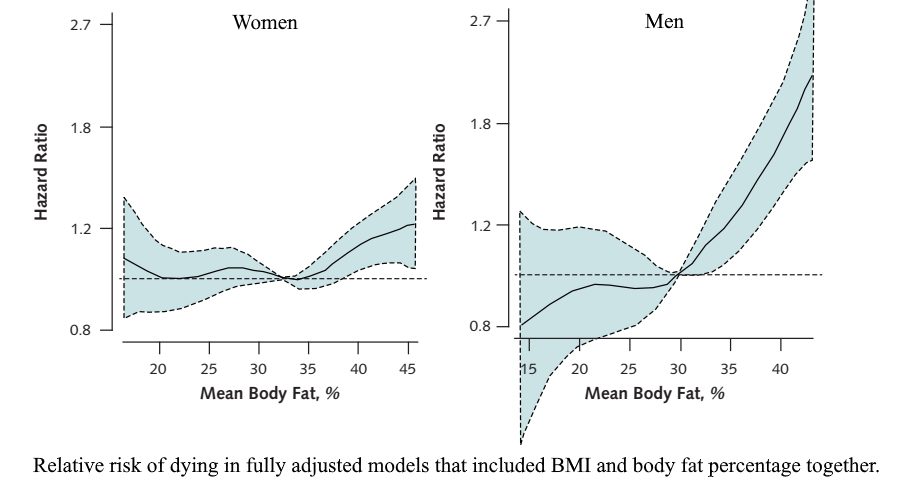What’s a healthy body fat percentage?
Can you be healthy at every size? Losing fat can obviously be healthy for some people, but why is fat loss healthy exactly? And can you lose too much fat or is leaner always better? Let’s look at what the scientific research says about what the most healthy body fat percentage is.
The healthiest BMI
There’s a ton of research on the relationship between body fat level and health, but the vast majority of the research uses Body Mass Index (BMI) as a proxy for body fat level. BMI is just weight in kilograms divided by height in meters squared (see formula below). BMI doesn’t directly measure body fat stores, so there are obvious problems with converting a BMI value to an exact body fat percentage.

Despite its problems, BMI remains very popular in research, because it’s cheap and quick to calculate, in contrast to laboratory grade body fat percentage measurements. Literally hundreds of studies have been done on the relationship between BMI and health and they show a reasonably consistent J-shaped relationship between BMI and all-cause mortality [2], the risk of dying from any cause. People generally have the lowest chance of dying in the coming years when their BMI is between 20 and 25. There is a progressively higher risk when they’re underweight or overweight and a much higher risk when they’re obese. See the figure below for the data from a meta-analysis on the topic.

The relative risk of dying (all-cause mortality) in men and women based on their BMI. Adapted from the Global BMI Mortality Collaboration (2016).
Before we get to why a low BMI is associated with poor health, it’s important to understand why a high BMI is bad for you.
The dangers of a high body fat percentage
In people that don’t lift weights, a high BMI is a reasonable indicator of excess body fat. Fat tissue, especially the visceral fat around your organs, negatively influences many systems in the body [2]. Visceral fat mass secretes inflammatory proteins, hormones and other substances that decrease our insulin sensitivity, promote inflammation and disrupt our hormonal balance. Excess fatty acids can also accumulate in our blood vessels and other organs, impairing their functionality. Being lean protects against diabetes, reduces chronic inflammation levels and corrects hormonal imbalances [2], whereas obesity is causally related to virtually all leading causes of death. In fact, being overweight is currently the second leading cause of death in the modern world and is expected to take over tobacco use soon. Experiments show losing body fat has very strong and consistent positive effects on almost every health biomarker, including blood sugar, heart rate, cholesterol levels and systemic inflammation markers. Being in energy deficit also promotes autophagy, a cellular clean-up mechanism that recycles and removes excess and dysfunctional components of the body. A 2021 meta-analysis confirms weight loss improves health-related quality of life in overweight individuals, with greater effects in more obese individuals [2].
The rate of weight loss and even diet quality often do not matter as much for our health as the loss of body fat.
Energy restriction, or rather staying lean throughout your life, also increases the lifespan of various animals, including primates. Studies on humans have also found improvements in biomarkers of longevity and many health biomarkers, operating via similar mechanisms as in rodents, suggesting we too can live longer if we stay lean [2, 3, 4, 5, 6, 7, 8, 9]. Energy restriction decreases inflammation and oxidative damage, which can decrease the rate our DNA degrades over time. However, not all research in primates shows calorie restriction improves longevity, and since it’s logistically and ethically infeasible to conduct life-long RCTs on humans until they die, we are limited to animal studies, epidemiological data, mechanistic evidence and RCTs up to 2 years in length. Centenarians – people that live over 100 years old – are rarely overweight and have been found to have a metabolic profile very similar to those of people in energy deficit. Calorie restriction is currently the most likely candidate to delay the health defects of age, with exercise being contender 2 mostly effective to manage the symptoms.
The health benefits of energy restriction are so profound that many researchers question if overweight individuals can even be perfectly healthy.
Can’t you be healthy at every size?
Older research identified certain people that were overweight but seemingly healthy based on their current biomarkers. This led to the idea of ‘healthy at every size’. However, many individuals who appeared to be ‘metabolically healthy overweight’ turned out to have considerable subclinical health problems. Moreover, when you follow these individuals over time, ‘healthy overweight’ individuals are also at greater risk than leaner individuals of developing metabolic risk factors and diseases [2, 3, 4, 5]. Physical activity can only compensate for excess body fat up to a point [2]: it can address the symptoms but not address the root cause of the problems. One scientific review concluded that “obesity and metabolic dysfunction are inseparable and that healthy obesity is best viewed only as a state of relative health but not of absolute health.” Other research has come to similar conclusions. Put bluntly, obesity has been called a timebomb by health researchers [2, 3].
Why being underweight can be bad for you
So if a low body fat level is so healthy, why do we see higher mortality rates among underweight people? Researchers have found multiple reasons for this.
1. Smoking, certain diseases and certain infections tend to lower your bodyweight by lowering your appetite and/or causing muscle wasting (cachexia). They obviously also increase your mortality risk. This causes a non-casual correlation between being underweight and mortality, a phenomenon called residual confounding. In other words, it’s not the leanness that kills these people but their disease or smoking habit.
2. Malnutrition is associated with increased mortality risk, obviously, and the risk of nutritional deficiencies is obviously also higher in people that eat less. If you think nutritional deficiencies are rare in modern times, I’m afraid nothing could be further from the truth. Many micronutrient deficiencies occur in a significant percentage of the population, such as iron, iodine, calcium, magnesium and vitamin A. At least a third of the world is estimated to be deficient in at least one micronutrient and in multiple regions the deficiency rate is over 50%. In a review of the prevalence of micronutrient deficiencies in popular diets, Calton (2010) concluded: “an individual following a popular diet plan as suggested, with food alone, has a high likelihood of becoming micronutrient deficient.” However, this is again not a problem inherent with being lean but with eating a diet that’s so poor overeating is the only way to avoid major deficiencies. On a whole foods based diet with a high nutrient density, you can still cover all your nutritional bases even in energy deficit.
3. And now for the real reason being underweight can be inherently bad for you: being underweight is associated with low muscle mass.
The health benefits of being jacked
Muscle mass is not commonly thought of as a necessarily healthy tissue, but muscle mass is positively associated with various health biomarkers and longevity. More muscular people tend to live longer than less muscular people. The most obvious health benefit of muscle mass is protection against physical frailty [2], such as from falls, but most benefits of higher muscle mass actually seem to be mediated by improved insulin sensitivity. While it’s difficult to separate the effects of exercise and muscle mass per se, higher muscle mass is generally positively related to insulin sensitivity and a lower risk of developing diabetes. Muscle mass is responsible for most of the blood sugar uptake after you eat, so it’s crucial to keep your blood sugar levels in check. Deconditioned muscles suffer from mitochondrial dysfunction, impaired blood flow, fat build-up and inflammation, causing insulin resistance in the muscles and consequently in the rest of the body. Healthy muscles essentially function as a sponge for blood glucose, thereby preventing hyperglycemia and reducing the demand for insulin production to keep blood sugar levels in check. Muscles also secrete myokines that can improve insulin sensitivity by regulating the activity of our pancreas and other organs. Insulin sensitivity strongly correlates with systemic inflammation, which in turn correlates with almost every health problem humans face, so having good insulin sensitivity is very beneficial.
The health benefits of muscle mass seem to be responsible for the seeming health benefits of a higher BMI in underweight populations. BMI does not differentiate between fat mass and muscle mass, so in underweight individuals, the adverse effects of low muscle mass can appear as adverse effects of a low BMI. It’s not the low fat mass but the low muscle mass that makes being underweight a problem. When correcting for the low muscle mass, most health risks from being underweight disappear [2]. See the following graphs adapted from Padwal et al. (2016), for example. In women, there was a significant mortality risk of higher body fat levels but no significant risk of lower body fat levels per se. In men, the data essentially showed that the leaner they were, the lower their chance of dying. Women in general suffer less from higher body fat levels than men, because women have a healthier body fat distribution with a ‘pear shape’ instead of the male ‘apple shape’ with high abdominal and visceral fat storage.

Of course, there’s more to life than not dying. Just because a body fat percentage is not associated with mortality, that doesn’t mean it’s optimally healthy. If we look at direct health biomarkers, such as insulin resistance or cholesterol levels, rather than death rates, many health benefits of energy restriction and fat loss continue without a clear limit. The leaner we get, the better these aspects of our health become. A recent 2022 review concluded obese and ‘normal weight’ individuals – a dubious term considering the majority of people in modern societies are overweight – achieve similar health benefits from losing fat: “the same degree of calorie restriction and the same amount of weight loss have multiple beneficial effects on health outcomes in individuals without obesity, similar to those observed in individuals with obesity.” A 2022 meta-analysis found that weight loss also improves cognitive functioning, including global brain functioning and memory, even in non-overweight individuals.
Considering fat loss provides certain health benefits no matter our starting body fat percentage, is there such a thing as being too lean?
The lowest healthy body fat percentage
Yes, there’s such a thing as too lean. For one, some body fat is essential to our survival. So called essential fat is required for the functioning of bone marrow, the central nervous system, internal organs, the cell membranes and, in women, the mammary glands and the pelvic region. Essential body fat stores comprise 3-5% of bodyweight for men and 8-12% for women. We can thus safely say those levels of body fat are unhealthy. “But Menno, this guy in my gym says he’s at 2% body fat.” Reality check: if you heard anyone boast about being that lean and they’re not speaking to you from the afterlife, they’re most likely misinformed. They probably used some crappy body fat caliper or BIA scale that’s calibrated for sedentary individuals.
Based on the above data, it seems that our health takes a turn for the worse somewhere between 12-16% body fat for women and 5-13% for men. This estimate is supported by studies on physique contest competitors, such as bodybuilders. Studies that follow physique competitors find that when they get even leaner than sixpack lean, their natural anabolic hormone production decreases. Men may even develop hypogonadism as their gonads stop producing healthy levels of testosterone. Women may lose their menstrual cycle (amenorrhea), with well-established adverse effects on fertility and health.
Research has also found that intensive exercise combined with prolonged energy deficits to cut to very low body fat levels suppresses our immune system [2] and may cause inflammation. However, the negative effects of dieting to very lean levels may be the result of insufficient micronutrient and anti-oxidant intake, which were explicitly diagnosed in one study, not necessarily their low body fat level. In other research, contest prep in female physique athletes who were already in great health still decreases inflammation levels and further improves cardiometabolic health. Most common health markers, such as insulin sensitivity, heart rate and cholesterol levels, typically keep improving even when approaching starvation-level body fat stores.
Third, the stress of trying to maintain an unsustainably low body fat level may start affecting your physical health. Physique contest competitors typically experience elevated cortisol levels and disrupted mood states. Mental health correlates with physical health. The healthier people are, the happier they tend to be. Being metabolically unhealthy is associated with a 19-60% increased risk of depression; if you’re also obese, the added risk increases to 30-83%. Psychological wellbeing is even directly correlated with fruit and vegetable consumption. Fruits and vegetable consumption even seem to increase wellbeing acutely. Mental stress is not just a killjoy but also effectively an off-switch for reproduction, growth, repair and digestion. That’s not a good state to be in long term.
Fortunately, any negative effects of being contest lean are temporary. Even women that completely lose their menstrual cycle during prep fully recover their hormonal health during a subsequent bulking phase [2] and our immune systems also fully recover.

For reference, this was yours truly at 10% body fat according to a well-calibrated InBody scan. Many people underestimate how lean 10% body fat is for a male. For women, this fat level corresponds to about 19% body fat.
So what’s a healthy body fat percentage?
Fat mass is generally detrimental: the lower your body fat level, the better most of your health biomarkers – insulin sensitivity, cholesterol levels, heart rate, etc. – tend to be. Being underweight is mostly a problem related to low muscle mass, not low fat mass. However, when you get to generally psychologically unsustainable body fat levels, such as for a physique contest, you may experience transient negative health effects. As a rule of thumb, the lowest sustainable body fat level for women is the level at which they can maintain their regular menstrual cycle, assuming they had one in the first place. This should be roughly in the range of 15-20% body fat. Higher body fat levels in women are generally not a health problem until at least 25%. Men should generally avoid spending prolonged periods of time below 10% body fat. A visible sixpack should be realistic, but keep an eye on your mental health and libido when dieting to even lower levels. There should be no serious health issues in men up to at least 15% body fat.
 Want more content like this?
Want more content like this?
Then get our free mini-course on muscle building, fat loss and strength.
By filling in your details you consent with our privacy policy and the way we handle your personal data.
